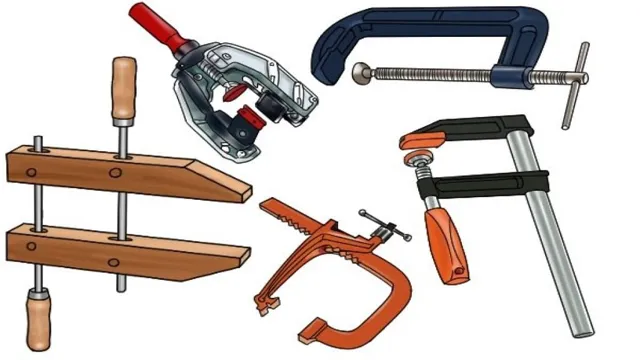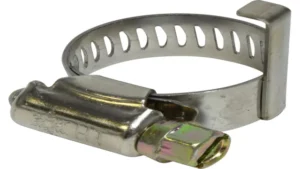Clamps may seem like a simple tool, but they come in a variety of shapes and sizes to serve different purposes. Whether you’re a carpenter, a welder, or a plumber, having the right clamp for the job can make all the difference in the quality of your work. In this comprehensive guide, we’ll explore the different types of clamps available and their applications.
From C-clamps to bar clamps, spring clamps to pipe clamps, we’ll cover it all. By the end of this guide, you’ll have a better understanding of which clamp is right for your project. So, let’s dive in and start exploring the world of clamps!
Introduction
When it comes to woodworking or metalworking, having the right clamp is crucial to ensure your project stays secure and in place. There are a variety of clamps that can be used, and the amount of pressure required, as well as the shape and size of the material being clamped, can determine which one to use. So, how many types of clamps are there? Well, there are several types of clamps, including C-clamps, bar clamps, pipe clamps, spring clamps, and quick-grip clamps, just to name a few.
Each clamp is designed for various purposes, such as holding wood while a saw blade moves through it, joining two pieces of wood together, or gluing a piece in place. With so many options available, it’s important to understand the different types of clamps and their intended use to ensure your project is successful.
Definition of Clamps
Clamps are common tools used in various industries for holding objects and materials securely in place. At their most basic, clamps consist of two metal plates or jaws that are connected by a screw or spring-loaded mechanism, and they come in many different shapes and sizes to suit different needs. Some clamps are designed for light-duty tasks, such as holding small pieces of wood or metal while they are being worked on, while others are heavy-duty enough to hold large structural components in place during construction.
Clamps are an indispensable tool for any handyman or craftsman, allowing them to work with greater precision and accuracy.

Importance of Clamps
Clamps are one of the most essential tools for any workshop or DIY project. These simple yet effective devices can be used to secure objects in place when gluing, welding, or cutting materials. Clamps come in a variety of shapes and sizes, each with their own unique features that make them suitable for different tasks.
They can be used to hold together two pieces of wood while you drill a hole, or keep a metal pipe steady while you cut it to size. In short, clamps are like an extra pair of hands that can help you get the job done right. So if you’re serious about your craft, investing in a good quality set of clamps is a no-brainer.
Whether you’re a professional carpenter or just looking to complete a weekend project, having the right clamps will make all the difference in the world.
Common Types of Clamps
If you’ve ever worked on a DIY project or a home renovation, chances are you’ve used a clamp or two. But how many types of clamps are there? Well, the answer is quite a few! The most common types of clamps include C-clamps, bar clamps, pipe clamps, spring clamps, hand screw clamps, and toggle clamps. C-clamps are named after the shape of their frame and are used for general purpose clamping.
Bar clamps have a long bar and can be adjusted to fit different sizes of material. Pipe clamps are ideal for securing pipes, while spring clamps are handy for light-duty clamping tasks. Hand screw clamps consist of two wooden jaws that are tightened by turning a screw, while toggle clamps have a small, pivoting arm that locks onto a workpiece.
With so many different types of clamps available, it’s important to choose the right one for your project to ensure a secure, stable hold.
C-Clamps
C-Clamps are versatile tools that are widely used in woodworking, welding, and metalworking. There are several types of C-Clamps available in the market, each designed for specific applications. One common type is the regular duty, forged C-Clamp, which is ideal for general clamping purposes.
They are sturdy and durable, making them suitable for heavy-duty tasks. On the other hand, light-duty C-Clamps are great for smaller jobs as they are easy to handle and do not require much force to hold the material in place. Deep throat C-Clamps are perfect for situations where clamping at a greater distance is necessary.
The screw is designed to reach further down the throat for a better grip. Locking C-Clamps, also known as Vises-Grip pliers, are adjustable and can hold various materials. They have a locking mechanism that allows for easy one-handed release and tightening.
Overall, C-Clamps are an essential tool for any workshop or DIY enthusiast, and choosing the right type for the job will ensure maximum efficiency and productivity.
F-Clamps
F-Clamps When it comes to clamping, F-Clamps are one of the most common types used by woodworkers, metalworkers, and DIY enthusiasts alike. These clamps have an “F” shape with a sliding jaw that can adjust to the desired location on the bar. They are known for their strong grip and stability, making them ideal for heavy-duty applications such as holding together glued-up panels or securing metal objects while welding.
There are various sizes available, ranging from small ones that can fit in the palm of your hand to larger ones that can hold objects up to several feet wide. F-Clamps come in different materials, such as aluminum, steel, and cast iron, each with its unique features and benefits depending on the application. Regardless of their differences, all F-Clamps share one thing in common – they are reliable tools that provide a secure grip and hold objects firmly in place.
Bar Clamps
Bar clamps are a popular type of clamp used in woodworking and metalworking projects. These clamps feature a long bar with one fixed and one adjustable jaw, allowing for a secure grip on materials of various sizes and shapes. One common type of bar clamp is a “F-style” clamp, which gets its name from the shape of its fixed jaw that resembles the letter “F.
” These clamps are versatile and can be used for a variety of projects, including gluing, drilling, sanding, painting, and more. Another type of bar clamp is a parallel clamp, which allows for even pressure distribution along the length of the clamp, making them ideal for larger projects. Both F-style and parallel clamps come in a range of sizes and materials, such as aluminum, steel, and cast iron, so it’s important to choose the right type for your project.
Overall, bar clamps are a must-have tool for any DIY enthusiast or professional woodworker.
G-Clamps
G-clamps are among the most common types of clamps used in various applications, particularly in woodworking and metalworking. They come in different sizes and shapes, but they all work similarly. G-clamps have a fixed jaw and a movable jaw, connected by a threaded screw.
To use a G-clamp, you simply slide the fixed jaw over the surface to be clamped and tighten the screw until it firmly grips the workpiece. The clamp’s shape allows for deep throating, which means it can secure a workpiece deep inside its jaws. This type of clamp is versatile and easy to use, making it a popular choice in many industries.
Spring Clamps
Spring clamps are a popular type of clamp used in woodworking, metalworking, and various other industries to hold materials together. They are called spring clamps because they have a spring mechanism that allows them to exert pressure on the material being held. There are many different types of spring clamps available, including hand clamps, corner clamps, bar clamps, and specialty clamps.
Hand clamps are the most common type of spring clamp and are simple to use, with a small spring-loaded handle that opens and closes the clamp’s jaws. Corner clamps are specially designed to hold two pieces of material at a right angle to each other, while bar clamps feature a long bar that can be adjusted to hold materials of various sizes. Specialty clamps, such as pipe clamps and edge clamps, are designed for specific applications.
When choosing a spring clamp, it is important to consider the material being held, the size and shape of the material, and the amount of pressure needed to hold it in place. With so many different types of spring clamps available, it’s easy to find the right one for your next project.
Pipe Clamps
One of the most versatile and widely used clamps in the world of carpentry and woodworking is the pipe clamp. Essentially, a pipe clamp consists of a threaded pipe that is fixed in a flat jaw and a movable jaw that can be adjusted by turning a handle. There are various types of pipe clamps available in the market, including bar clamps, quick-release clamps, parallel jaw clamps, and deep-throat clamps.
Bar clamps are the most common type and are used for a wide range of applications. Quick-release clamps, as the name suggests, are designed to quickly release the pressure applied on the object being clamped. Parallel jaw clamps are perfect for holding flat pieces of wood, while deep-throat clamps are used for clamping joints at a considerable distance from the edge.
Regardless of the type, pipe clamps are a must-have for any woodworker, enabling them to hold objects tight during the gluing or assembly process, ensuring precise results every time.
Less Common Types of Clamps
If you’re wondering how many types of clamps there are beyond the standard screw and trigger clamps, there are actually quite a few. One option is the spring clamp, which uses a spring to hold objects together. They’re great for holding small items in place while working on them.
Another type is the band clamp, which uses a strap or band to hold large or irregularly shaped objects. You can also find C-clamps, which are great for holding items in place while you’re working on them, or bar clamps that use a bar to apply pressure to an object. If you’re working with pipes, you might opt for a pipe clamp or a chain clamp which are designed for those specific purposes.
Regardless of which type you use, always make sure the clamp is properly secured to avoid accidents and injuries.
Hand Clamps
Hand clamps are a less common type of clamp that are useful for a variety of applications. Unlike traditional clamps that require a screw or lever to tighten, hand clamps can be easily tightened by hand. These types of clamps come in a variety of sizes and styles, including bar clamps, C-clamps, and quick grip clamps.
Hand clamps are ideal for holding materials in place while sawing, drilling, or sanding. They are also useful for clamping small pieces together when glueing or welding. The advantage of hand clamps is that they are easy to use, don’t require any tools, and can be adjusted quickly and easily.
If you’re looking for an efficient way to hold your materials in place, hand clamps are definitely worth considering.
Screw Clamps
Screw clamps are a type of clamp that applies pressure by screwing a threaded rod into a clamping surface. They come in various sizes and are commonly used for woodworking projects, but can also be used in metalworking and other applications. Screw clamps can be either manual or powered and typically have a jaw capacity that ranges from a few inches to several feet.
One of the benefits of screw clamps is their versatility, as they can be used to clamp objects together both vertically and horizontally. With their strong, reliable grip, screw clamps are an excellent choice for any DIYer or woodworker looking to secure their workpiece firmly in place. So if you’re in the market for a robust and versatile clamp, consider investing in a screw clamp for your next project.
Toggle Clamps
Toggle Clamps are a type of clamp that is not as common as other types available in the market. They are a unique type of clamp that operates with the help of a lever system. The lever system allows the clamp to apply a strong force on the workpiece, thereby keeping it in place.
Toggle clamps are easy to operate, and they come in different sizes and shapes to suit different applications. They are commonly used in woodworking, metalworking, and welding applications. Toggle clamps are versatile and can be used for a variety of holding operations such as clamping, gripping, and securing.
They are an ideal choice for applications where high clamping force is required with minimum effort and provide an efficient way of holding workpieces without the risk of damaging them.
Corner Clamps
When it comes to woodworking, clamps are absolutely essential to get things done efficiently. While F-clamps and bar clamps are commonly used in various woodworking projects, there are several less-common types of clamps that can be just as useful, one of which is the corner clamp. Corner clamps are specifically designed to be used on corners and are ideal for creating frames and boxes, as they’re capable of holding boards at a perfect right angle.
They come in various sizes and are generally quite easy to use, providing that your boards have been properly milled and squared. Whether you’re a professional woodworker or just starting, adding a couple of corner clamps to your collection can be a game-changer in ensuring that your projects come out perfectly every time.
Conclusion
In conclusion, the world of clamps is a diverse and fascinating one, with a surprisingly large number of variations available to suit virtually any application. From humble screw clamps to high-tech hydraulic models, there’s a clamp out there for every need, and knowing your options is key to success. Whether you’re a woodworker, mechanic, or DIY enthusiast, don’t hesitate to look beyond the basics and explore the exciting world of clamps – you never know what you might discover!”
FAQs
1. What is a clamp and what is its purpose? A: A clamp is a device designed to hold objects firmly in place. Its purpose is to prevent movement or separation of the objects being held. 2. What are the different types of clamps? A: There are several types of clamps, including C-clamps, spring clamps, bar clamps, pipe clamps, hand screw clamps, toggle clamps, and quick-release clamps. 3. What is a C-Clamp and how is it used? A: A C-Clamp is a type of clamp that has a C-shaped frame. It is used to hold two pieces of material together, such as metal or wood. The clamp is tightened by turning a screw that is attached to the flat side of the C. 4. How do spring clamps work? A: Spring clamps are used to hold light objects in place and are designed with two spring-loaded jaws that are forced together by a spring. To use them, simply open the jaws and position them around the object, then release. 5. What are bar clamps used for? A: Bar clamps are used for larger projects and are designed to apply pressure evenly across a wide surface area. They consist of a long bar that is tightened or loosened by turning a screw at the end of the bar. 6. What is a pipe clamp and how is it used? A: A pipe clamp is designed to hold round or cylindrical objects, such as pipes or poles. The clamp consists of two jaws that are tightened by turning a screw, which helps secure the object in place. 7. What is a hand screw clamp? A: A hand screw clamp is a simple type of clamp that consists of two wooden jaws that are attached to a threaded rod. The jaws can be adjusted by turning the rod, allowing the clamp to accommodate objects of different sizes.






